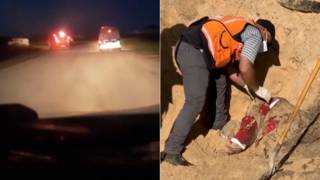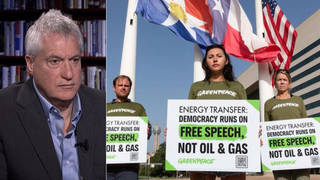
Lawmakers and the NAACP are calling for an investigation into reports that federally funded scientific experiments in 2000 spread sewage sludge on yards in poor black neighborhoods to test if it could fight lead poisoning in children. The Associated Press reported Sunday that researchers spread a mix of human and industrial wastes from sewage treatment plants on the lawns of nine low-income families in Baltimore and a vacant lot next to an elementary school in East St. Louis, Illinois. We speak with John Heilprin, the AP reporter who broke the story. [includes rush transcript]
Transcript
AMY GOODMAN: Lawmakers and the NAACP are calling for an investigation into reports that federally funded scientific experiments in 2000 spread sewage sludge on the yards in poor black neighborhoods to test if it could fight lead poisoning in children. The Associated Press reported on Sunday that researchers spread a mix of human and industrial wastes from sewage treatment plants on the lawns of nine low-income families in Baltimore and a vacant lot next to an elementary school in East St. Louis. The families were told the sludge was safe and not informed about the toxic ingredients the sludge could contain. The report implicated researchers and funders from Johns Hopkins University, the Kennedy Krieger Institute, the Environmental Protection Agency, the Housing and Urban Development Department and the Agriculture Department.
The researchers say the experiment successfully reduced the amount of lead in the soil. But some scientists question the findings, as well as the choice of neighborhood and lack of transparency with the residents. The Senate Environment and Public Works Committee will convene a hearing on the subject next month.
I’m joined right now in Washington, D.C. by John Heilprin. He’s the Associated Press reporter who broke this story. Welcome to Democracy Now!, John.
JOHN HEILPRIN: Hi, Amy. Thanks for having me.
AMY GOODMAN: Explain what happened.
JOHN HEILPRIN: Well, we found that some research had been done in Baltimore, where they were spreading this Class A sewage sludge fertilizer on lawns in, as you said, poor black neighborhoods and not fully disclosing all of the risks that are involved with a fertilizer like this. And we investigated.
AMY GOODMAN: Now explain who were the scientists who were doing this and what was in this sludge. And how did you hear about this? I mean, you’re the UN reporter now for Associated Press, though for years you were what? The environment reporter?
JOHN HEILPRIN: That’s right. I covered the national environmental beat for the AP from January of ’01 until November of ’07, and I just transferred to the United Nations. I covered all sorts of stories on the environmental beat.
I found sewage sludge to be an intriguing story, because it really goes back to the heart of the nation’s environmental policies and the movement to clean up the nation’s waterways and water pollution and building wastewater treatment plants starting in the ’70s. It was one of the biggest projects that EPA undertook. And essentially, to get the rivers and keep the oceans clean, they created sludge. And sludge is basically the distilled solids that are removed from wastewater. And in order to cut costs, the sludge is — most of it is returned to the land as fertilizer. There’s two different grades: Class A, Class B. The stuff that was involved in the Baltimore study is the Class A, which is of a higher treatment level.
AMY GOODMAN: Explain who the families were who accepted that the sludge be spread in their yards.
JOHN HEILPRIN: Well, one of the problems is we don’t know exactly who they are. No one will identify them. They were all families from these poor, low-income neighborhoods, black neighborhoods in Baltimore in so-called empowerment zones. And all of them agreed to take on — to have this Class A fertilizer tilled into their lawns. These were basically bald dirt lawns with high levels of lead contamination. And the Class A sludge fertilizer was tilled into the lawn to create grass cover, and on the theory that if the children ate the dirt, they would be better protected from the lead contamination, because the sludge would mix with the lead in the soil and make that pass safely through the body. That was the researchers’ theory.
AMY GOODMAN: But John, these families were given a financial incentive to accept this sludge on their lawn.
JOHN HEILPRIN: They were. They were given food coupons, free lawns, free doormats. We didn’t put that in the story. And they were essentially told that this was commercial-grade fertilizer, that it was safe, as you reported, and that they would be better off, that they would be better off using this fertilizer than before.
The thing that I found interesting was that this government-sponsored research essentially operates on the premise that this fertilizer is safe enough and good enough to eat, even though the researchers say that the fertilizer was not fed directly to the children. The premise of the research is that if they eat it, they will be better off.
AMY GOODMAN: John Heilprin, you quote a scientist, Dr. McBride, saying that it’s actually not safe for the kids. There’s a real question here. The soil chemist from the Cornell Waste Management Institute said, when eaten, “it’s not at all clear that the sludge binding the lead will be preserved in the acidity of the stomach. Actually thinking about a child ingesting this, there’s a very good chance that it’s not safe.”
JOHN HEILPRIN: Well, that’s right. There’s — first of all, the EPA’s inspector general has twice said that there’s no way that the EPA can assure the public that sludge is safe. This theory that the phosphate and iron can bind to the lead might work in the soil; however, as Murray McBride said, the stomach acids will probably break down — will break out the lead from the soil. In fact, in 2003, another scientist, an EPA microbiologist, David Lewis, had also come to the same conclusion. He was working within the EPA’s Office of Research and Development, and he used to call this theory “sludge magic.”
AMY GOODMAN: You have this soil chemist, McBride, and others questioning the choice of the neighborhoods for the studies and why the families weren’t told about the possible harmful ingredients in the sludge that they were allowing to be laid in their yard.
JOHN HEILPRIN: Well, no one knows, of course, exactly why they picked those families or the neighborhoods, but I do think that nationwide, as with the spreading of sludge and with the research, it tends to go to areas where it is not challenged. In sludge spreading, the sludge is generated by cities, big city, rich cities, like New York, LA. They try to get rid of it in more rural areas, predominantly minority areas. And some of this research, as we reported, in East St. Louis also was done next to an elementary school. It was tilled into the soil next to an elementary school with 300 students, all of whom were black, and almost all were poor. No one can say for sure why that was done, but it seems to me that perhaps it’s done in areas where there are fewer questions. That’s what some of the experts say.
AMY GOODMAN: So what’s going to happen now? Can you talk about the calls for an investigation by groups like the NAACP?
JOHN HEILPRIN: Well, the Senate Environment Committee is going to hold a hearing on sludge, investigate this matter. There have also been calls for a House committee, the House Oversight and Government Reform Committee, to get involved and the NAACP. And I suppose they wil generate pressure on the Kennedy Krieger Institute in Baltimore and Johns Hopkins.
AMY GOODMAN: John Heilprin, we’ll have to leave it there. I want to thank you very much for being with us, a reporter with the Associated Press who broke this story. We’ll link to it at democracynow.org.











Media Options